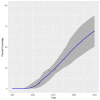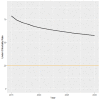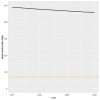Projecting the lives saved by continuing the historical scale-up of child and maternal health interventions in Mozambique until 2030
- PMID: 31131106
- PMCID: PMC6513506
- DOI: 10.7189/jogh.09.011102
Projecting the lives saved by continuing the historical scale-up of child and maternal health interventions in Mozambique until 2030
Abstract
Background: Over the past 20 years, Mozambique has achieved substantial reductions in maternal, neonatal, and child mortality. However, mortality rates are still high, and to achieve the Sustainable Development Goals (SDGs) for maternal and child health, further gains are needed. One technique that can guide policy makers to more effectively allocate health resources is to model the coverage increases and lives saved that would be achieved if trends continue as they have in the past, and under differing alternative scenarios.
Methods: We used historical coverage data to project future coverage levels for 22 child and maternal interventions for 2015-2030 using a Bayesian regression model. We then used the Lives Saved Tool (LiST) to estimate the additional lives saved by the projected coverage increases, and the further child lives saved if Mozambique were to achieve universal coverage levels of selected individual interventions.
Results: If historical trends continue, coverage of all interventions will increase from 2015 to 2030. As a result, 180 080 child lives (0-59 months) and 3640 maternal lives will be saved that would not be saved if coverage instead stays constant from 2015 to 2030. Most child lives will be saved by preventing malaria deaths: 40.9% of the mortality reduction will come from increased coverage of artemisinin-based compounds for malaria treatment (ACTs) and insecticide treated bednets (ITNs). Most maternal lives will be saved from increased labor and delivery management (29.4%) and clean birth practices (17.1%). The biggest opportunity to save even more lives, beyond those expected by historical trends, is to further invest in malaria treatment. If coverage of ACTs was increased to 90% in 2030, rather than the anticipated coverage of 68.4% in 2030, an additional 3456 child lives would be saved per year.
Conclusions: Mozambique can expect to see continued reductions in mortality rates in the coming years, although due to population growth the absolute number of child deaths will decrease only marginally, the absolute number of maternal deaths will continue to increase, and the country will not achieve current SDG targets for either child or maternal mortality. Significant further health investments are needed to eliminate all preventable child and maternal deaths in the coming decades.
Conflict of interest statement
Competing interests: The authors have completed the Unified Competing Interest form at www.icmje.org/coi_disclosure.pdf (available on request from the corresponding author), and declare no conflict of interest.
Figures





References
-
- (INE) INdE. Moçambique Inquérito Demográfico e de Saúde 1997. Calverton, Maryland: Macro International Inc.; 1998.
-
- da Saude M. (MISAU), Instituto Nacional de Estatística (INE), (ICFI) II. Moçambique Inquérito Demográfico e de Saúde 2011. MEASURE DHS/ICF International 2013.
-
- Ministerio da Saude (MISAU). Moçambique Rd. Plano Estratégico do Sector da Sade 2014-2019. Maputo, Mozambique: 2013.
-
- World Bank. Global Financing Facility: Investment Cases. Availble: https://www.globalfinancingfacility.org. Accessed: 1May 2018.
MeSH terms
LinkOut - more resources
Full Text Sources
Medical
Research Materials
Miscellaneous
